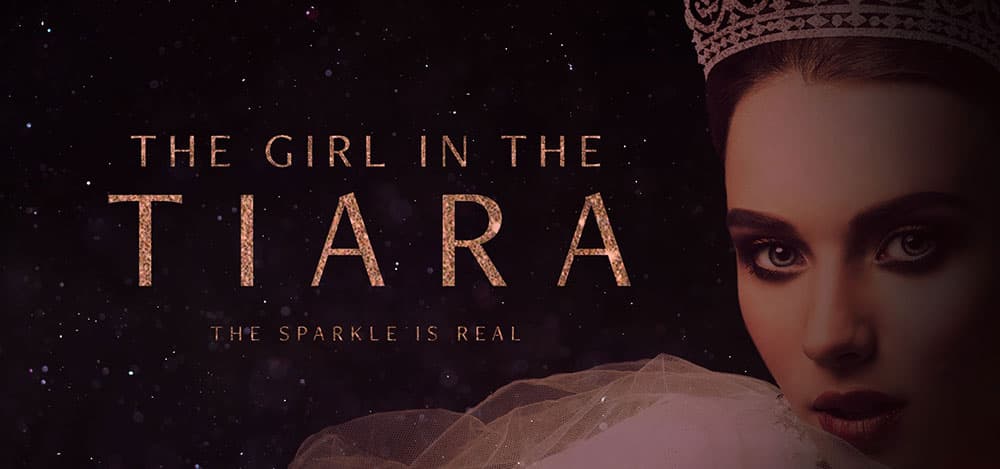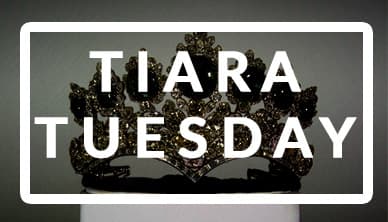Share this Post
Table of Contents
The Russian Aquamarine Tiara | What Happened To This Tiara? | Where Is This Tiara Now? | How Would I Wear It?
This tiara was created around 1900, most likely for Empress Alexandra, wife of Nicholas II (and mother of Grand Duchesses Olga and Marie, for you Romanov Legacy readers). We don’t know this for sure, however, since there are no pictures of Alexandra wearing this tiara.
These honkin’ aquamarines are arranged in a traditional Russian kokoshnik style, with a platinum frame and diamond accents. It has a matching necklace and earrings, too. Gemstones have their own language, just like flowers, in which aquamarines stand for love and diamonds stand for eternity. Nicholas and Alexandra are one of the 20th century’s great love stories, despite the unhappy ending, so I’d like to believe this really was Alix’s tiara. Here’s what it looked like the last time it was seen, as part of a Christie’s exhibition in 2017:

What Happened to It?
As with most Russian royal jewels, things went haywire during the revolution. All we know is that it was in the hands of the Soviet government in the 1920s. Sometime in the mid-1920s, Soviet representatives brought a bag of Romanov jewelry to Paris to sell it. A representative of London-based jeweler Wartski bought this tiara from them. His name was Emanuel Snowman, and he was the founder’s son-in-law. (I can’t make this shit up. The guy’s name was actually Snowman.) He was one of the first jewelers to open negotiations with the Soviets in order to buy confiscated Romanov property. Snowman spent more than a decade traveling back and forth to Russia, bringing out treasures that include a golden chalice that belonged to Catherine the Great. He often traveled with a man named Armand Hammer. I told you – I just can’t make this shit up.
Snowman often traveled with a man named Armand Hammer. I told you – I just can’t make this shit up.
If the jeweler’s name sounds familiar, it might be because Wartski is the firm that sold the “lost” Faberge egg that turned up in the US in 2014, to an undisclosed buyer for somewhere in the neighborhood of 20 million pounds. They also made Kate Middleton’s wedding ring.
If you’re in the Washington DC area, you can go see Catherine the Great’s chalice at the Hillwood Estate. Holy shit, you guys – upon further perusal, they also have the diamond Romanov nuptial crown. Anyone in the DC area who can go see this and report on what it looks like in real life?
Where Is This Tiara Now?
We don’t know. In this case, however, it’s not because the tiara hasn’t been seen since the ’20s. It’s been seen three times. The first sighting was in the 1980s, when the tiara and its matching necklace and earrings came up for auction at Sotheby’s.
The second sighting was in 2014, when the tiara alone showed up in a private sales tour hosted by Christie’s. The tour hit Monte Carlo, Moscow, Dubai, and London, which doesn’t really narrow things down at all in terms of possible buyers. The catalog description, as far as I can tell, only said, “property of a European noble family.” My family is American and poor, so obviously that wasn’t us.
The third sighting was in 2017, when the tiara was part of a Christie’s exhibition, Magnificent Tiaras, that took place in London from December 1-15.
How Would I Wear It?
Acquired by a man named Snowman and filled with ice-colored aquamarines? This has Frozen written all over it. If I were the wife of a Disney exec or whoever wrote “Let It Go,” I would demand this tiara be located and wrapped up as a birthday present.
Not being either of those, however, my mind drifts to something else that’s pretty damn close to this color: a Bombay Sapphire bottle. I’d wear this tiara to raise a toast to 2015, and to you, my dear Tiara Tuesday readers. Tiaras inspire the imagination. They’re works of art. They’re mysteries. They’re fun to imagine on my head, in my daily life, as if I were the princess I dreamed I was when I was a little girl. They take me back to a time and place when dreams really did come true. And when I sober up and realize they don’t, there’s always some schadenfreude in the tales of tiaras whose owners fell from grace. That’s why I love tiaras and their stories. I’m so glad you’re coming along for the ride. To 2015, to tiaras, and to you.
That’s the Russian aquamarine tiara!
Want to suggest a tiara? Drop its name or a photo link into the comments. I’ll do my best to find something interesting in its history.
Image Credits
Alix: After Hughes & Mullins: Ryde, Isle of Wight, public domain via Wikimedia Commons
Screenshot of tiara exhibition info: Christie’s

Love Royalty and Tiaras?
You might like my other site, The Girl in the Tiara. I created it to write about amazing royal women and their tiaras. It’s like Drunk History meets The Crown.

Tiara Tuesday Archives
Visit the archives to read about more royal shenanigans. And by shenanigans, I mean war, revolution, betrayal, lust, murder, diamonds, and Princess Stéphanie’s chafing dish.
Share this Post
